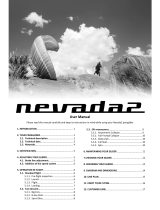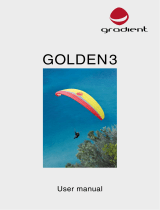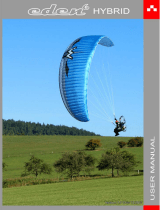Page is loading ...

/ PACE
PRO GUIDE

PRO GUIDE // PACE
TABLE OF CONTENT
1 Introduction 3
2 Description 4
3 Technical Data 5
4 Line System 5
5 Acceleration System 6
6 Flight Techniques and Characteristics 6
7 Descent Techniques 8
8 Materials 9
9 Homologation 10
10 Closing Words 11
11 Loops & Hooks 12
12 Line Schematic 13
13 Line Length 13
14 Risers 14
15 Overview Glider 15
16 Test Protocoll 16
2 Table of content

1 INTRODUCTION
Welcome to skywalk!
Congratulations on the purchase of your new PACE and thank you for your trust in us
and in our products. In this manual you will find product-specific information that will help
you quickly get to know your new paraglider to ensure your fun for a long time.
General information about the most important safety-relevant points for handling your
paraglider can be found in the attached „BASIC GUIDE“.
We are always open for questions, comments or critique and are happy to provide you at
any time with further information!
Your skywalk Team
PURE PASSION FOR FLYING
Edition 1.0 / 10_23
The latest version of the manual can be found on
www.skywalk.info
Introduction 3

PRO GUIDE // PACE
2 DESCRIPTION
The PACE was designed as a minimalist descent aid in a single skin design.
The PACE is so lightweight and compact that you can always take it with you during
demanding activities such as trail running or mountaineering without it adding
any weight.
PILOT REQUIREMENTS
The PACE has been tested according to the LTF/EN standard and has passed with a rating
of B. In principle, any pilot can fly the PACE after training. However, a single skin paraglider
differs in its handling compared to a conventional paraglider.
More detailed information on takeoff, flight, landing and extreme flight behavior can be
found in the individual chapters. The ultra-lightweight construction requires a certain level
of caution in handling.
SCOPE OF DELIVERY
The PACE comes standard with deflation bag, inner bag, compression strap, riser bag
and “BASIC GUIDE”.
4 Description

3 TECHNICAL DATA
Size
Cell number
Area flat (m²)
Wingspan flat (m)
Aspect ratio flat
Area projected (m²)
Wingspan projected (m)
Aspect ratio projected
min. profile depth (cm)
max. profile depth (cm)
Middle line length without risers (m)
Line consumption (m)
Weight (kg)
Take-off weight from - to (kg)
Winch certified
JET FLAP Technology
Paramotor homologation
Accelerator
Brake line travel max. (cm)
Trimmers
Number of seats
4 LINE SYSTEM
The layout of the suspension points is designed for optimal load distribution and a long
lifespan. With all considerations and calculations however, our focus is always on safety.
The mix of materials used on the lines of the PACE is an ideal combination of durability,
low stretch and low drag.
The skywalk PACE has 3 A-, 3 B-, 1 C-, 1 D-, and 1 stabilo line.
The main-stabilo is connected with the B-riser. The brake lines are not load-bearing and
lead from the trailing edge over the main brake lines through the brake pulleys on the
C-risers to the brake handles. A marking on the main brake line indicates the position of
the handle attachment.
This setting should not be lengthened, for example, to provide more brake travel in extreme
flight situations or during landing, nor shortened such that the glider is flown constantly
with some brake on.
Technical data 5
70+ 85+ 95+
41 41 41
16,00 18,00 20,00
8,39 8,90 9,38
4,4 4,4 4,4
13,63 15,34 17,04
6,72 7,13 7,51
3,31 3,31 3,31
78 83 87
229 243 256
5,37 5,70 6,00
295 314 332
1,05 1,15 1,24
50-90 65-100 70-110
yes yes yes
no no no
no no no
no no no
61 62 66
no no no
1 1 1

PRO GUIDE // PACE
To provide a better overview and to make sorting easier, the lines
have different colors:
> the A-main lines and the A-risers are red.
> the B-main lines are yellow.
> the C-line as well as the D-lines are blue.
> the stabilo lines are orange.
> the main brake lines are orange.
The skywalk PACE has 3 risers per side:
> the A-lines as well as the B-lines lead to the A-riser
> the C-lines as well as the stabilo lines lead to the B-riser
> the D-lines lead to the C-riser
A schematic drawing of the risers can be found at the back of the manual.
5 ACCELERATION SYSTEM
The skywalk PACE does not have an acceleration system but can be retrofitted with a trim
system. However, when using the trim system, the type approval according to EN/LTF
becomes invalid.
There are no other adjustable, removable, or variable devices present.
6 FLIGHT TECHNIQUES AND CHARACTERISTICS
WINCHTOWING
The skywalk PACE is well suited for winch towing. Make sure that you only use certified
winches and that you climb from the ground at a flat angle.
The pilot must have had proper towing instruction and must ensure that the winch
operator has had proper training that includes paragliders. When launching on a winch,
always fly with a lot of feeling and don’t brake too much as your glider will already have
an increased angle of attack. We recommend the use of a towing adapter.
FLYING WITH A MOTOR
Currently, the PACE has no certification for flying with a motor.
You can find out the current status of motor certification at any dealer or importer, or by
asking skywalk directly.
6 Acceleration System

LAUNCH
The ultralight PACE rises very quickly above the pilot without overshooting, so it is not
necessary to hold the A-risers in hand. For a forward launch, simply place the risers
over your arms, a comfortable walk forward is sufficient and the PACE will be positioned
above the pilot. Lateral deviations are best corrected by walking underneath.
Keep the brakes in your hand during the launch, but typically, the PACE does not require
corrections using the brakes.
FLYING IN TURBULENT CONDITIONS
The PACE stabilizes itself and levels itself above the pilot when necessary.
In turbulent conditions, it is advisable to fly the PACE with some brake pressure.
This enhances overall stability by increasing the angle of attack. Unlike a conventional
paraglider, the PACE does not produce a pitching motion in front of the pilot.
This leads to a significant speed reduction of the wing and a reduction in performance
in turbulent conditions.
Therefore, we recommend flying the PACE in less turbulent conditions to achieve the
best possible performance.
LANDING
In the final approach with a single skin wing, it is essential to fly as fast as possible
to create a smooth flare.
Applying the brakes too early can completely destroy the lift.
The PACE has been equipped with the NUDGE system. This system generates
additional lift during landing.
FULL STALL
The PACE reacts differently in a full stall compared to a conventional paraglider.
During recovery, the canopy rises extremely quickly above the pilot but does not shoot
in front of the pilot. However, because the canopy rises so rapidly above the pilot,
there is a risk of twisting during an asymmetric recovery.
Flight Techniques and Characteristics 7
WE DO NOT RECOMMEND FLYING A FULLSTALL WITH THE PACE!

PRO GUIDE // PACE
SIV
The PACE has no inertia, which makes the wing‘s movements extremely quick and strongly
encourages oversteer when recovering from maneuvers. The concept of the PACE is to fly
down from mountains in calm conditions.
However, to ensure safe flying for users, this wing‘s design offers an exceptionally high re-
sistance to collapses and outstanding inherent stability. These features have been spe-
cifically developed for comfortable flying and optimal stability in calm conditions and are
not suitable for use in SIV-trainings..
WE STRONGLY DON´T RECOMMEND TO DO A SIV-TRAINING WITH THE PACE!
You can find further information on practices and characteristics of flying in the enclosed
“BASIC GUIDE“.
7 DESCENT TECHNIQUES
PULLING BIG EARS
In contrast to the spiral, your forward speed with »big ears« is higher than your rate
of descent. This rapid descent aid is used to quickly exit danger zones by flying straight
ahead in a desired direction.
The risk of collapses in turbulent air is significantly reduced with big ears. To perform
this maneuver, proceed as follows (according to DHV teaching instructions):
> Grab the outer A-lines (AIII) above the risers with your palms facing outward and pull
the lines down.
> Keep the brake handles and the outer A-lines in your hands during the maneuver.
> Check the symmetry of the collapsed glider.
> To recover, slowly release the A-lines. The glider usually will reinflate by itself.
> During the maneuver, the ears of the PACE are not stable and will therefore flutter.
> To speed up reinflation, pull lightly on the brakes. Another proven technique
is to first reinflate one side of the glider, then then other. This can reduce the
risk of a stall.
8 Descent techniques

Examples:
> If the pilot is surprised near a summit with little ground clearance by strong wind or
a thundercloud, neither a B-stall nor a spiral dive can help.
> If the pilot is stuck in very strong lift, it is advisable to exit the lift band with the use
of big ears and to find sinking air in which to lose altitude.
B-LINE STALL
This maneuver is not possible with the PACE.
For fast descent use a spiral dive or big ears.
You can find further information about descent techniques in the enclosed
“BASIC GUIDE”.
8 MATERIALS
The skywalk PACE is manufactured from the highest quality materials. skywalk has
selected the best possible combination of materials with regard to resilience, weight
and longevity. We are aware that the durability of the glider is a deciding factor
in the pilot’s satisfaction.
WINGS AND RIBS
Upper sail: Porcher Skytex 27 double coated, Dominico 10D
Ribs: Porcher Skytex 27g hard, Skytex 32g hard
LINES
A, B, C, S Main lines: Liros PPSLS 180/125; Edelrid 8001U - 70
A, B, C Middle lines: Edelrid 8001U - 130/90/70/50
A, B, C, D Top lines: Liros DC 35
Brake lines: Liros DFLP 200/32, PPSL 125, DC 35;
Edelrid 8001U - 90/50
RISERS
4mm Amare
Materials 9

PRO GUIDE // PACE
9 HOMOLOGATION
The PACE is certified to LTF II 91/09 and EN926-1, EN926-2 in the category B.
The PACE is defined as a lightweight sport aircraft with an empty weight of less than
120kg in the paraglider category. The many homologation tests are the last hurdle in the
development of a skywalk paraglider. The homologation test flights only take place when
the test team is completely happy with the glider development.
We remark that the certification results will differ during flight in thermals or turbulent air.
The homologation informs solely regarding the paraglider performance during extreme-
flight-manoeuvres performed in stable air conditions. These extreme-flight-manoeuvres
during the homologation process should thus not be over-valued.
Remember that certification maneuvers were carried out with a harness in the group GH
with a carabiner distance (middle to middle) of 40-48 cm. If another harness is used, the
glider may display flight characteristics that differ from those in the description.
HARNESS MEASUREMENTS DURING THE TEST FLIGHTS
10 Homologation
Total weight in flight (kg) < 80 80-100 100 >
Width (cm-measurement ‚A‘) 40
+
–
2 44
+
–
2 48
+
–
2
Height (cm-measurement ‚B‘) 40
+
–
1 42
+
–
1 44
+
–
1
Width of harness attachment points Height of harness attachment points
B
A

Closing words 11
10 CLOSING WORDS
The skywalk PACE is at the pinnacle of paraglider development in the market for single
skin wings and shows what is possible regarding lightweight construction, safety and inno-
vation. It cost us a lot of time to develop this glider, but it was also a lot of fun. In this
development we recognize the challenge of making the right product for every area and
individual taste. We are pleased if you notice this during your first flight and if you feel
a certain unity with your glider from the very beginning.
The PACE will provide you with plenty of joy over many years if you treat it and care for it
properly. Respect for the demands and dangers of our sport are essential for successful
and beautiful flights.
Even the safest paraglider can be dangerous due to misjudgments of meteorological
conditions or pilot error. Always remember that flying sports are potentially risky and that
you are responsible for your own safety. We advise you to fly carefully and to respect laws
in the interest of our sport, because every pilot always flies at his or her own risk!
WE WISH YOU A LOT OF FUN WITH YOUR NEW GLIDER AND ALWAYS
HAPPY LANDINGS!!
Your skywalk Team

PRO GUIDE // PACE
12 Loops&Hooks
11 LOOPS & HOOKS
The PACE is equipped with “Loops & Hooks”.
These are used to secure the canopy in difficult terrain. Proceed as follows:
Connect the line of the hook-pin with the loop on the canopy.
The loop is sewn on the upper sail about 20cm above the cell opening on rib 6.
Encumber the hook or put it into the ground.

brs1
brm3
brsu1
brmu2
brmu1
brm1
brm2
cm3
bm7
bm1
bm2
bm3
bm4
bm8
bm9
bm5
bm6
cm2
cm1
dm3
dm2
dm1
cmu6
cmu5
stm2
stm1
dmu6
dmu5
dmu4
dmu3
cmu4
cmu3
dmu2
dmu1
cmu2
cmu1
am1
am2
am3
am4
am5
am6
am7
am9
am8
br1
br2
br3
br4
br5
br6
br7
br8
br9
br10
st4st3
st2st1
c1a c1c
c1b
d1a d1c
c2a c2c d2a d2c
d1b
c2b d2b
c3a c3c
c3b
d3a d3c
c4a c4c d4a d4c
c5a c5b d5a d5b
c6a
a15a
a16a
b18a
b16a b16b
b15a b15b
b14a b14b
b13a b13b
b12a
b10a
b12b
b11a b11b
a12a a12b
a11a a11b
b10b
b9a
b9b
a10a a10b
a9a a9b
b8a b8b
b7a b7b
a8a a8b
a7a a7b
b6a b6b
b5a b5b
a6a a6b
a5a a5b
b4a b4b
b3a b3b
a4a a4b
a3a a3b
b2a b2b
b1a b1b
a2a a2b
a1a a1b
b17a
b17b
b18b
a16b
a15b
a13a
a14a a14b
a13b
c6b d6a d6b
d3b
c4b d4b
a18
a19
a17
(as3, as2, as1) (bs1, bs2, bs3) (sts1, cs1) (ds1) (brs1)
Brake HandleA -Riser B - Riser C - Riser
d7
bs1as1
as2
as3
cs1 ds1
bs2
bs3
sts1
12 LINE SCHEMATIC
This line schematic is only for
illustration purposes.
13 LINE LENGTH
Total line length PACE size: 70+, 85+ and 95+: www.skywalk.info
Single line length PACE size: 70+, 85+ and 95+: www.skywalk.info
Line schematic | Line length 13
or put it into the ground.
The total line length has to be measured under a tension of 50N. The difference between
the measured length and the original length should not exceed ±10 mm.
Compliance of the test sample’s suspension lines, brake lines and risers were checked by
the testing laboratory after the test flights were completed.

PRO GUIDE // PACE
A, B, C
510 mm
14 RISERS
The difference between the measured riser lengths and the original riser lengths
should not exceed ±5mm.
14 Risers

Overview Glider 15
15 OVERVIEW GLIDER
1 Main lines
2 Top lines
3 Cell openings
4 Top sail
5 Trailing edge
6 Nameplate

PRO GUIDE // PACE
16 Test Protocol
TEST PROTOCOL Date:
Customer, Name:
Adress: Phone:
Glider: Size: Serial number:
Type certificate number: Date of last check:
Date of first flight: Year of construction:
Accomplished checking: Results [+/–]: Description of failure: Suggested repairs:
Identification:
Visual check of canopy:
Upper surface:
Lower surface:
Profiles:
Line flares:
Leading edge:
Trailing edge:
Crossports:
Visual check of lines:
Seams:
Abrasion spots:
Core withdrawals:
Visual check of connectionparts:
Suspension line screw locks:
Risers:
Length measurement:
Risers:
Lines:
Examinations of the canopy:
Firmness of canopy:
Porosity:
+
+
+
+
+
+
+
+
+
+
+
+
+
+
+
+
-
-
-
-
-
-
-
-
-
-
-
-
-
-
-
-
+-
16

Test Protocol 17
Examinations of the lines:
Firmness of main lines: daN
Results [+/–]: Description of failure: Suggested repairs:
Visual check of trimming:
Checkflight necessary?
Type certificate patch?
Identification plate?
Condition: New
Very good condition
Good condition
Well used
Heavily used, but within homologation standards, frequent checks required
No longer airworthy, outside of the limit values.
Repairs made?:
Signature of tester: Date:
Name of tester: Firm stamp:
+
+
+
+-
-
-
-

PRO GUIDE // PACE
skywalkparagliders
Skywalk GmbH & Co. KG
Windeckstr. 4 | 83250 Marquartstein
+49 (0) 8641/69 48 0
inf[email protected] | www.skywalk.info
For great stories, awesome photos and adventures
all over the globe – follow us on social media.
Tag us and use #purepassionforflying to get featured!
/


